Start Spring Gardening with these Six Steps
/Spring is always an exciting time of year. Melting snow reveals a forgotten landscape full of potential! Before we enjoy our yards this season, simple maintenance will maximize the beauty and productivity of your garden.
1. Take Care of Perennials
After enduring a long winter, it’s understandable that we seek immediate gratification in our yards when spring finally does arrive. That’s why one of the first things I like to do in the garden is clean up perennial beds.
When the last snow melts and the ground dries a little, cut back any perennials that weren’t cut back last fall — things like the ornamental grasses and coneflowers whose sturdy stems looked great covered with winter’s hoar frost.
If you’re still having flashbacks to winter, seeing new buds and sprigs of green beneath last season’s foliage will be very cathartic and therapeutic!
Be sure to never cut back the perennials too much, staying a couple of centimeters above the crown to prevent scalping and damaging your plants.
2. RAKE LEAVES
At the same time as you’re cutting back your perennials, rake any leaves and debris from around your plants. You’ll probably notice some bulbs beginning to emerge as well as many ladybugs which are also beginning to wake up — sure signs of spring!
This is also a great time to thin out and divide many perennials that may be taking more than their fair share of space in the planters. Although the act of ripping apart plants may seem brutal, some perennials, such as irises, bee balm, and coneflowers, actually become rejuvenated and thrive when this is done on occasion.
Most plants will tolerate a spring division, but the general rule of thumb is to divide spring-flowering plants in the fall, and summer-flowering plants in the spring. Not only will you be able to expand your own flower beds with these divisions, split perennials also make great gifts!
Once the divisions and necessary clean-ups in the perennials beds are complete, spread some fresh mulch to top off your flower beds. Not only will the mulch conserve soil moisture, protect roots during the heat of the summer, and make things easier to maintain by keeping weeds at bay, it will make the colours of your perennials pop.
3. pRUNE Woody Shrubs and Trees
Spring is a great time to prune most shrubs and trees! With the warmer temperatures and longer sunlight, the sap will begin to flow within and buds will begin to swell. The still-naked branches will allow you to get a good overall view of the woody so that it can be thinned out appropriately and rejuvenated.
At this point, you should also be able to tell which branches have winter die-back (they will snap and break, not bend) and need to be removed. Keep in mind, however, that not all trees and shrubs should be pruned in spring. Shrubs like lilac, mock orange, forsythia, and white-flowering spirea bloom from buds set in the fall, so pruning them in the spring will remove their flowers. In cases like this, pruning can be done after they are finished blooming.
Trees like birch and maples have a very heavy sap flow in the spring, so pruning will cause them to bleed. Prune these trees in July when they’re fully leafed-out. When it comes to pruning, though, it’s important to know the limits of your capabilities. Some pruning should be left to professional arborists, especially when dealing with large trees.
5. PREP Vegetable Garden
Our gardening season in southern Alberta is short enough, so don’t waste time when it comes to prepping your veggie garden!
When the snow melts away for the fourth or fifth time in the spring and the frost begins to come out, add compost to your garden plots and work it into the soil. This will add necessary nutrients to the soil for the plants to utilize as they grow, but it will also loosen your garden soil and promote soil drying and warming.
Some vegetables such as spinach, lettuce, radishes, and Swiss chard can be seeded early, as they don’t mind the cooler soil temperature and can withstand some light frost that might yet come. Remember, the sooner those seeds are sewn, the faster you’ll be able to enjoy fresh produce from your own garden.
Some other things that you can do in your vegetable garden to prepare for spring is build those garden structures you dreamt about all winter. Now is a great time to build raised planters, garden trellises, and obelisks that will help your gardening season be more productive and enjoyable.
6. RAKE & AERATE Lawn
Your lawn will be one of the first things to green up this spring, but there are some things you can do to ensure that it continues to stay green, even well into the summer heat.
Raking your lawn will remove the thatch left behind from last year’s mowing and clean up any debris left behind by the mice who tunneled below the snow drifts over winter. A regular rake will often do the trick for this, but occasionally you may want to use a power rake to ensure that the deep-down thatch is being removed. While you’re renting or hiring out a power rake, you may want to also consider aerating your lawn.
Again, it’s not necessary to do this every year, but if your lawn is prone to compaction or experiencing dry patches during the summer, aerating may be beneficial. Also use this time to top-dress your lawn with a mixture of compost and sand. Not only will the mix penetrate the holes left by the aerator bringing nutrients to the roots, it will also fill low spots or unevenness at the surface of your lawn.
These are just a few things that you can do to get your landscape ready for the growing season. A little work now will go a long way to ensure that you’ll be able to enjoy a successful yard this season. Besides, what better way to send the winter blues packing for another year than to get your fingernails dirty again in the garden?










